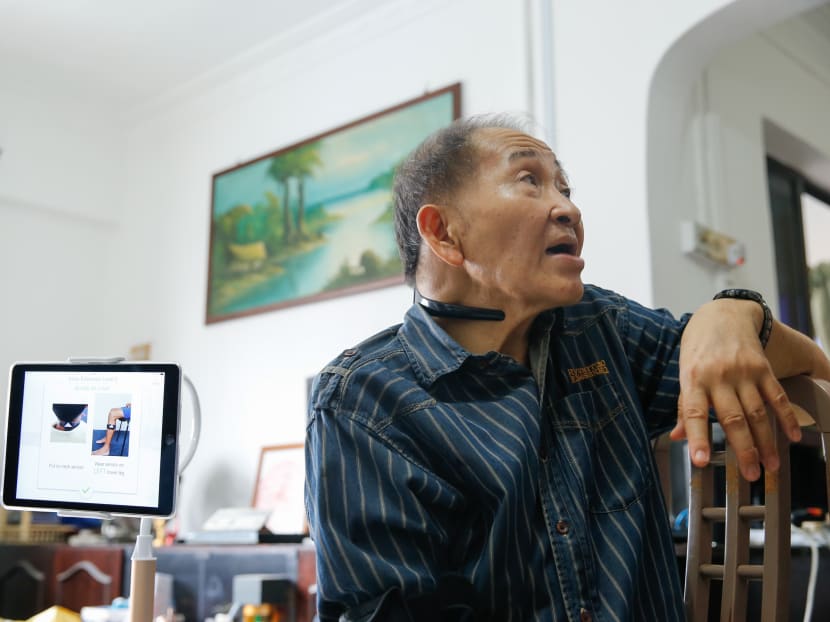Tele-rehab programme gets thumbs-up from 72-year-old
SINGAPORE — Post-surgery and a fall later, Mr Chin Tian Loke, 72, was in pain and wanted to get better quickly.

The Smart Health Telerehab system operates using an iPad. With the help of this system, Chin Tian Loke, 72, no longer has to leave his house for physiotherapy. He broke his spinal tail bone from a fall and since his surgery, he requires physiotherapy to further strengthen his body muscles. Photo: Najeer Yusof/TODAY
SINGAPORE — Post-surgery and a fall later, Mr Chin Tian Loke, 72, was in pain and wanted to get better quickly.
Physiotherapy sessions at hospitals were not showing results — until “the best thing that has happened to the whole healthcare industry” was offered to him, he said.
He was referring to the Smart Health TeleRehab programme, jointly developed by the National University of Singapore’s Department of Electrical and Computer Engineering and the Saw Swee Hock School of Public Health.
It allows patients to perform guided rehabilitation (rehab) exercises in the comfort of their home, and their progress is remotely monitored by their therapists through a video-recording function.
Mr Chin is full of praise for this tele-rehab system because he was growing weary of conventional physiotherapy sessions in hospitals. They were scheduled a month apart, sometimes even two, for him. “I saw no improvement at all,” the former maintenance officer at a condominium said.
Mr Chin suffers from scoliosis, a medical condition that causes his spine to curve to the side. Last June, he underwent a major neck and spinal cord surgery at Ng Teng Fong General Hospital, after his doctors warned him that he may lose his nerve functions, which may lead to paralysis.
Shortly after being discharged from a four-month hospital stay, Mr Chin fell last November and broke his spinal tail bone. He had to undergo physiotherapy in hospital and was put under the care of TOUCH Home Care (THC), a non-profit home-care agency.
Of the half a dozen therapy sessions that he attended, he said: “I’m only allowed half an hour and they teach you just one or two exercises.” He found that a lot of time was wasted, not to mention that transport cost was also an issue for him.
Then two weeks ago, he was chosen to be among seven patients from THC to take part in a pilot study of the Smart Health TeleRehab programme.
The exercises they have to do are shown on a tablet, and the patients have to put on wearable sensors.
Now, Mr Chin estimates that he does his therapy at least once a day. “You can do it as long as you have free time to do it... It’s very, very useful,” he said.
Ms Vivian Lim Feng Yu, 31, who is Mr Chin’s physiotherapist at THC, said that he has spent at least 35 minutes doing six sets of exercises each session, as often as eight times in the last two weeks.
Ms Lim controls from her tablet the difficulty level of the exercises, how many sets Mr Chin has to repeat, among other things. After each tele-rehab session, she receives a chart detailing his performance, along with a video-recording of the session.
Mr Chin said that no matter how forgetful he is, he could refer to the video and restart again. “Or contact my physiotherapist by video-conferencing,” he said.
His healing has been progressing by “leaps and bounds”, he claimed.
“I have major improvement in my muscle strength, it’s incredible,” he said, adding that the pain he had experienced in his arm before tele-rehab had completely dissipated. “I can lift my arm already.”
This was corroborated by Ms Lim, who noted a marked improvement in Mr Chin’s walking speed, apart from his increased arm strength. “He doesn’t realise it … but he’s walking much better, he is more stable, and faster than usual,” she said. His reliance on his walking aid has been significantly reduced.
Mr Chin hopes to “recover quickly” and “have stronger legs”, so that he may leave home and be out and about.
“My main purpose is to go out. Go find a hawker centre and fill my stomach up,” he quipped.






